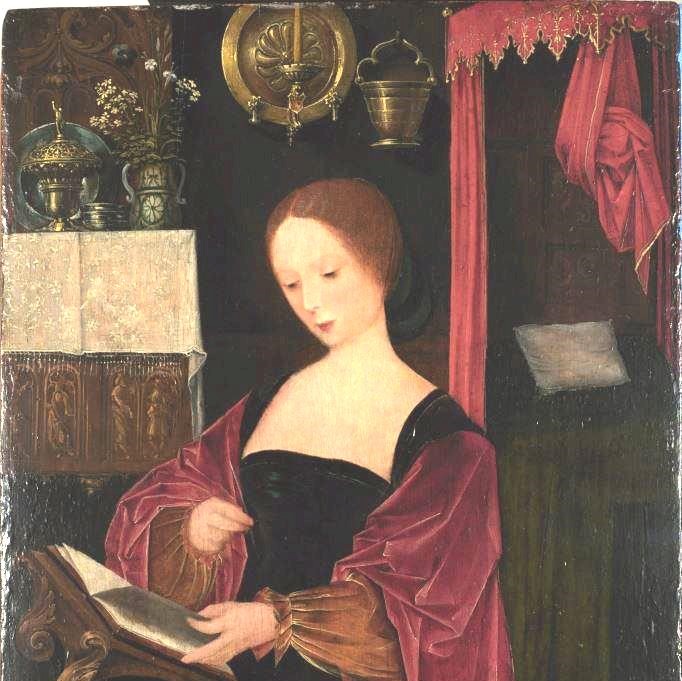Digital imaging to unveil traditional craft methods
A case study of a Renaissance Flemish panel
DOI:
https://doi.org/10.7577/formakademisk.5400Emneord (Nøkkelord):
Art as craft, technical investigation, digital imaging, Master of the Female Half-Lengths, FlemishSammendrag
To understand the creation and the function of a Flemish oil on panel, non-invasive technical investigations including UV, IRR, X-ray and µ-XRF have been used as a method to unveil its specific material features. The undated and unsigned panel has been attributed to The Master of the Female Half-Lengths possibly active during the early 16th Century, due to its stereotype motif, materials and dimensions. The analysis reveals that the panel has several damages due to natural and forced interventions. The painting process shows various inconsistencies, interpreted with the aid of literary sources as a product of a workshop adapted to producing art as a response to the great demand of Flemish panels from the blooming Early Dutch art market.
Referanser
Bomford, David, Drayman-Weisser, Terry, Gifford, Melanie and McGlinchey, Chris. (2010). Art as Evidence : The Scientific Investigations of Works of Art. The Getty. https://www.getty.edu/conservation/publications_resources/videos/public_lecture_videos_audio/art_evidence.html (accessed: 2023-07-07).
Billinge, Rachel, Campbell, Lorne, Dunkerton, Jill, Foister, Susan, Kirby, Jo, Pilc, Jennie, Roy, Ashok, Spring, Marika & White, Raymond. (1997).Methods and materials of Northern European painting in the National Gallery, 1400-1550. National Gallery Technical Bulletin, 18.
Curry, Christina & Ghys, Bob. (2006). La peinture ancienne et ses procédés : copies, répliques et pastiches [Ancient painting and its processes: copies, replicas and pastiches]. In Marcq H. Verougstraete, Jacqueline Couvert, Roger Schoute, & Anne Dubois (Eds.), Design transfer in Pieter Brueghel the younger’s workshop: a step-by-step reconstruction based on technical examination of his paintings (pp. 196-207). Peeters publisher.
Hahr, August. (1905). Gammalflamsk konst i Uppsala universitets tafvelsamling [Old Flemish art in Uppsala University's panel collection]. In Studier tillägnade Henrik Schück på hans 50-årsdag den 2 november 1905 af vänner och lärljungar. Hugo Gebers förlag.
Izzo, Francesca Caterina, Kratter, Matilde, Nevin, Austin & Zendri, Elisabetta. (2021). A critical Review on the Analysis of Metal Soaps in Oil Paintings. Chemistry Open, 10, 904–921. https://chemistry-europe.onlinelibrary.wiley.com/doi/pdf/10.1002/open.202100166 (accessed: 23-05-24).
Kammerer, Paul, Lettner, Martin, Zolda, Ernestine & Sablatnig, Robert. (2006). Identification of drawing tools by classification of textural and boundary features of strokes. Pattern Recognition Letters, 28(6), 710-718. https://doi.org/10.1016/j.patrec.2006.08.003
Nicolaus, Knut. (2001). Handbok för Restaurering av målningar (Ulla-Märta Westerståhl, trans.) Könemann Verlagsgesellschaft.
Spring, Marika. (2017). New insights into the materials of fifteenth- and sixteenth-century Netherlandish paintings in the National Gallery, London. Heritage Science, 5(40). https://doi.org/10.1186/s40494-017-0152-3
Vergaras, Alejandro. (2007). Patinir Essays and Critical Catalogue. Museo Nacional del Prado.
Vermeylen, Filip. (2010). The Colour of Money: Dealing in Pigments Sixteenth Century Antwerpen. In Jo Kirby, Susie Nash, & Joanna Cannon. (2010). Trade in artists' materials : markets and commerce in Europe to 1700 (pp. 356-365). Archetype Publications. https://www.academia.edu/5438222/The_Colour_of_Money_Dealing_in_Pigments_in_Sixteenth-Century_Antwerp

Nedlastinger
Publisert
Hvordan referere
Utgave
Seksjon
Lisens
Opphavsrett 2023 Teresia Stroemgren

Dette verket er lisensiert under Creative Commons Attribution-NoDerivatives 4.0 International License.
- Forfatteren(e) beholder sin opphavs- og kopieringsrett til eget manuskript, men gir tidsskriftet varig rett til 1) å fremføre manuskriptet for offentligheten i den opprinnelig publiserte digitale form, og 2) å registreres og siteres som første publisering av manuskriptet.
- Forfatteren må selv forvalte sine økonomiske kopieringsrettigheter overfor eventuell tredjepart.
- Tidsskriftet gir ingen økonomisk eller annen kompensasjon for innsendte bidrag, medmindre det er gjort særskilt avtale om dette med forfatteren(e).
- Tidsskriftet plikter å arkivere manuskriptet (inklusive metadata) i den opprinnelig publiserte digitale form, i minst ett dertil egnet åpent tilgjengelig langtidsarkiv for digitalt materiell, som for eksempel i de norske universitetenes institusjonsarkiv innen rammen av NORA-samarbeidet.
Verket vil bli publisert OpenAccess med en Creative Commons 4.0-lisens som tillater alle å lese, dele og tilpasse innholdet, også kommersielt, under lisensvilkårene:
Dette verket må tilskrives/ krediteres på riktig måte, en lenke må gis til CC-BY 4.0-lisensen, og endringer som er gjort må angis på en rimelig måte, men ikke på noen måte som antyder at lisensgiveren støtter deg eller din bruk.



